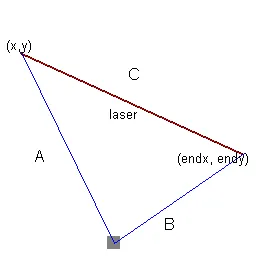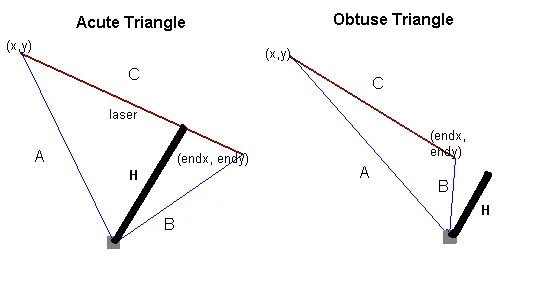编辑:这是我正在开发的游戏,我正在尝试检测激光是否与物体碰撞,这里是样本http://jefnull.com/references/lasers/。最具描述性的文件是http://jefnull.com/references/lasers/lasers.js。
检测一个点是否在线段上
编辑:这是我正在开发的游戏,我正在尝试检测激光是否与物体碰撞,这里是样本http://jefnull.com/references/lasers/。最具描述性的文件是http://jefnull.com/references/lasers/lasers.js。
1
由于我的先前答案说明了如何确定一点是否在该线上,而实际问题似乎是“我如何判断该点是否靠近线段”,因此我添加了一个新答案。
这是一个技巧:首先找到障碍物到线段两个端点的距离。这两个距离不能唯一地确定障碍物的位置,但它们确实可以唯一确定一个三角形,该三角形有三个特定的边长,然后我们可以立即使用几何学进行计算。

我稍微改变了颜色。无论如何,我在上面的评论中提到,您应该使用点-直线距离公式来查找障碍物与线之间的距离。但这并不会真正起作用。原因是这是点到线的距离。因此,对于下面的两个示例,该公式将计算图片中的粗体距离H。

那不对!!
因此,这里是查找由激光形成的线段与障碍物之间距离的伪代码:
Find the distance from my point to the line segment!
if the angle at (x,y) is obtuse
return A
else if the angle at (endx,endy) is obtuse
return B
else
return H
以下是您可以使用的数学公式来实现上述伪代码:
- 要查看在
(x,y)处的角度是否是钝角,请找出是否满足条件B^2 > A^2 + C^2。如果是,则该角度是钝角。 - 要查看在
(endx,endy)处的角度是否是钝角,请找出是否满足条件A^2 > B^2 + C^2。如果是,则该角度是钝角。 - 为了计算
H,使用两种不同的方法来找到三角形的面积 - 通常的base*height/2和海龙公式(Heron's Formula)。
这意味着你应该:
set s = (A+B+C)/2
The area of the triangle is C*H/2
The area of the triangle is also sqrt(s*(s-A)*(s-B)*(s-C))
So H = 2/C * sqrt(s*(s-A)*(s-B)*(s-C)).
最终结果是这样的:
if B^2 > A^2 + C^2
return A
else if A^2 > B^2 + C^2
return B
else
s = (A+B+C)/2
return 2/C * sqrt(s*(s-A)*(s-B)*(s-C))
我认为这应该足以帮助你实现你真正想要做的事情。祝好运,不要放弃!
更明确地说,如果你的点是
A = (Ax, Ay), B = (Bx, By), C = (Cx, Cy),那么你想要检查以下内容:(Cy - Ay) / (Cx - Ax) = (By - Ay) / (Bx - Ax)
相反,您应该检查
(Cy - Ay) * (Bx - Ax) = (By - Ay) * (Cx - Ax).
5
Infinity == Infinity,因此这不会导致实际错误(尽管在数学上不正确)。 - pimvdb= 替换为“在0.05范围内”...但我不确定那会有什么影响。 - Chris Cunningham首先,Razack提供的答案是最数学上正确的答案,尽管高度理论化。如果您支持这个答案,请考虑同时支持他的答案。
我已经在以下有用的JavaScript函数中实现了他的方法。特别注意calcIsInsideThickLineSegment(...)函数。随意使用。
//Returns {.x, .y}, a projected point perpendicular on the (infinite) line.
function calcNearestPointOnLine(line1, line2, pnt) {
var L2 = ( ((line2.x - line1.x) * (line2.x - line1.x)) + ((line2.y - line1.y) * (line2.y - line1.y)) );
if(L2 == 0) return false;
var r = ( ((pnt.x - line1.x) * (line2.x - line1.x)) + ((pnt.y - line1.y) * (line2.y - line1.y)) ) / L2;
return {
x: line1.x + (r * (line2.x - line1.x)),
y: line1.y + (r * (line2.y - line1.y))
};
}
//Returns float, the shortest distance to the (infinite) line.
function calcDistancePointToLine(line1, line2, pnt) {
var L2 = ( ((line2.x - line1.x) * (line2.x - line1.x)) + ((line2.y - line1.y) * (line2.y - line1.y)) );
if(L2 == 0) return false;
var s = (((line1.y - pnt.y) * (line2.x - line1.x)) - ((line1.x - pnt.x) * (line2.y - line1.y))) / L2;
return Math.abs(s) * Math.sqrt(L2);
}
//Returns bool, whether the projected point is actually inside the (finite) line segment.
function calcIsInsideLineSegment(line1, line2, pnt) {
var L2 = ( ((line2.x - line1.x) * (line2.x - line1.x)) + ((line2.y - line1.y) * (line2.y - line1.y)) );
if(L2 == 0) return false;
var r = ( ((pnt.x - line1.x) * (line2.x - line1.x)) + ((pnt.y - line1.y) * (line2.y - line1.y)) ) / L2;
return (0 <= r) && (r <= 1);
}
//The most useful function. Returns bool true, if the mouse point is actually inside the (finite) line, given a line thickness from the theoretical line away. It also assumes that the line end points are circular, not square.
function calcIsInsideThickLineSegment(line1, line2, pnt, lineThickness) {
var L2 = ( ((line2.x - line1.x) * (line2.x - line1.x)) + ((line2.y - line1.y) * (line2.y - line1.y)) );
if(L2 == 0) return false;
var r = ( ((pnt.x - line1.x) * (line2.x - line1.x)) + ((pnt.y - line1.y) * (line2.y - line1.y)) ) / L2;
//Assume line thickness is circular
if(r < 0) {
//Outside line1
return (Math.sqrt(( (line1.x - pnt.x) * (line1.x - pnt.x) ) + ( (line1.y - pnt.y) * (line1.y - pnt.y) )) <= lineThickness);
} else if((0 <= r) && (r <= 1)) {
//On the line segment
var s = (((line1.y - pnt.y) * (line2.x - line1.x)) - ((line1.x - pnt.x) * (line2.y - line1.y))) / L2;
return (Math.abs(s) * Math.sqrt(L2) <= lineThickness);
} else {
//Outside line2
return (Math.sqrt(( (line2.x - pnt.x) * (line2.x - pnt.x) ) + ( (line2.y - pnt.y) * (line2.y - pnt.y) )) <= lineThickness);
}
}
要查看一些使用漂亮的SVG图形的代码示例,请参见我用于调试的此链接: https://jsfiddle.net/c06zdxtL/2/
4
function isOnLine(x, y, endx, endy, px, py) {
var f = function(somex) { return (endy - y) / (endx - x) * (somex - x) + y; };
return Math.abs(f(px) - py) < 1e-6 // tolerance, rounding errors
&& px >= x && px <= endx; // are they also on this segment?
}
x、y、endx和endy是定义直线的点,可以用它们来建立该直线的方程。然后,填入px,检查f(px) = py是否成立(实际上要检查足够小以避免舍入误差)。最后,检查线段是否在区间x ... endx内定义。
5
endx = x 且 endy = y,那么我猜你会遇到一些有趣而不愉快的行为。你应该将 pimvdb 的出色完整答案与我的吹毛求疵的答案结合起来,以得到正确的答案。 :) - Chris Cunningham假设点C的坐标为(Cx,Cy),直线AB的两个端点分别为(Ax,Ay)和(Bx,By)。 设P为点C在直线AB上的垂足。参数r表示P在直线AB上的位置,可以通过向量AC与向量AB的点积除以向量AB长度的平方来计算:
(1) AC dot AB
r = ---------
||AB||^2
r has the following meaning:
r=0 P = A
r=1 P = B
r<0 P is on the backward extension of AB
r>1 P is on the forward extension of AB
0<r<1 P is interior to AB
The length of a line segment in d dimensions, AB is computed by:
L = sqrt( (Bx-Ax)^2 + (By-Ay)^2 + ... + (Bd-Ad)^2)
so in 2D:
L = sqrt( (Bx-Ax)^2 + (By-Ay)^2 )
and the dot product of two vectors in d dimensions, U dot V is computed:
D = (Ux * Vx) + (Uy * Vy) + ... + (Ud * Vd)
so in 2D:
D = (Ux * Vx) + (Uy * Vy)
So (1) expands to:
(Cx-Ax)(Bx-Ax) + (Cy-Ay)(By-Ay)
r = -------------------------------
L^2
The point P can then be found:
Px = Ax + r(Bx-Ax)
Py = Ay + r(By-Ay)
And the distance from A to P = r*L.
Use another parameter s to indicate the location along PC, with the
following meaning:
s<0 C is left of AB
s>0 C is right of AB
s=0 C is on AB
Compute s as follows:
(Ay-Cy)(Bx-Ax)-(Ax-Cx)(By-Ay)
s = -----------------------------
L^2
Then the distance from C to P = |s|*L.
3
function is_point_on_segment (startPoint, checkPoint, endPoint) {
return ((endPoint.y - startPoint.y) * (checkPoint.x - startPoint.x)).toFixed(0) === ((checkPoint.y - startPoint.y) * (endPoint.x - startPoint.x)).toFixed(0) &&
((startPoint.x > checkPoint.x && checkPoint.x > endPoint.x) || (startPoint.x < checkPoint.x && checkPoint.x < endPoint.x)) &&
((startPoint.y >= checkPoint.y && checkPoint.y >= endPoint.y) || (startPoint.y <= checkPoint.y && checkPoint.y <= endPoint.y));
}
测试:
var startPoint = {x:30,y:30};
var checkPoint = {x:40,y:40};
var endPoint = {x:50,y:50};
console.log(is_point_on_segment(startPoint ,checkPoint ,endPoint ));
根据直线方程y = mx + b,其中m是斜率,x是x轴上点的值,b是y截距(即直线与y轴相交的点)。
m(斜率)= endy - y / endx - x; 例如,如果一条线从(0,0)开始并结束于(4,2),则m = 4-0 / 2-0 = 2;
b(y截距)= 0;
现在举个例子,假设你提供了一个点(1,2),要判断它是否在直线上。可以通过x坐标计算出y坐标,即
y = mx+b
y = 2(1)+ 0; //这里x是给定点的x坐标 y = 2; 这恰好与给定点的y坐标相同,因此我们可以得出结论:该点在直线上。如果该点的值为(2,2),根据方程式计算结果为y = 4,而这与给定点的y坐标不相等,因此它不在直线上。
function isOnLine(initial_x, initial_y, endx, endy, pointx, pointy, tolerate) {
var slope = (endy-initial_y)/(endx-initial_x);
var y = slope * pointx + initial_y;
if((y <= pointy+tolerate && y >= pointy-tolerate) && (pointx >= initial_x && pointx <= endx)) {
return true;
}
return false;
}
6
不适用于给定参数相同的值:
initial_x: 1, initial_y: 6
返回false,点坐标为:pointx: 1, pointy:6 - Adrien Parrochia这是我的isOnLine实现
function isOnLine(a, b, p, tolerance) {
var dy = a.y - b.y;
var dx = a.x - b.x;
if(dy == 0) { //horizontal line
if(p.y == a.y) {
if(a.x > b.x) {
if(p.x <= a.x && p.x >= b.x)
return true;
}
else {
if(p.x >= a.x && p.x <= b.x)
return true;
}
}
}
else if(dx == 0) { //vertical line
if(p.x == a.x) {
if(a.y > b.y) {
if(p.y <= a.y && p.y >= b.y)
return true;
}
else {
if(p.y >= a.y && p.y <= b.y)
return true;
}
}
}
else { //slope line
var s = dy/dx;
var py = s * p.x;
if(py <= p.y + tolerance && py >= p.y - tolerance) {
if(a.x > b.x) {
if(p.x <= a.x && p.x >= b.x)
return true;
}
else {
if(p.x >= a.x && p.x <= b.x)
return true;
}
}
}
return false;
}
1
原文链接